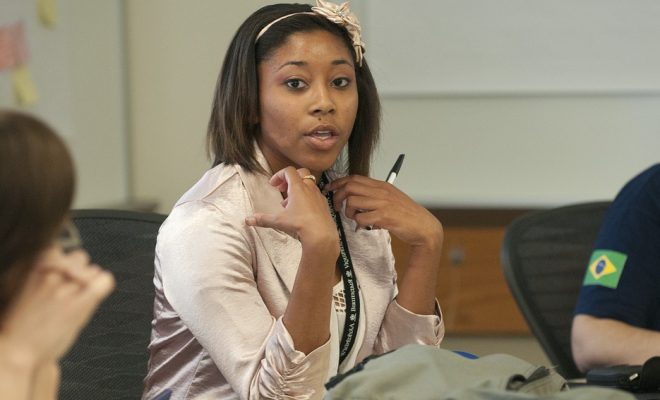Can real global learning happen online?


A student in Uganda communicates with her learning partners in New Orleans. Photo: Theo Niyirinda
This fall, after getting to know each other in online video exchanges, some Ugandan high school students told a group of students in New Orleans that most Ugandans have no reliable electricity and use candles or lanterns after dark. Over the following weeks, the students worked together to build solar-powered lights. An education technology startup called Level Up Village supplied both schools with solar cells, batteries and LEDs, along with 3-D printers to fabricate the housings, tutorials on electricity and computer-aided design, and an online workspace for posting notes and swapping ideas.
Global learning initiatives like this are booming, because the technologies that long made our world seem smaller are finally at the point where they can seamlessly make classrooms that much bigger. For years, educators have wanted to teach “global competency”—meaning a grasp of international issues and the ability to work with people around the world. Until recently, however, virtual border crossings were typically one-time extravagances pulled off in a handful of elite schools.
Now, growing computing power, accelerating broadband, social media and virtual reality are bringing global education to the masses. Schools are connecting and collaborating globally in all sorts of ways, ranging from Tweets and Skype sessions to full-blown online global learning platforms, most of which will be up for discussion in the webinars and keynote speakers of this week’s online Global Education Conference.
“Kids will be global with or without us. They have contacts around the world, and they’re using social media to connect about things they’re passionate about,” said Brandon Wiley, founder and president of the consulting firm GlobalEdLeader.
This kid-first vision drives The Wonderment, a free app enabling students around the world to creatively engage with each other, which the Salt Lake City nonprofit Kidnected World launched in 2014.
“It can be hard for kids to recognize something they want to change in the world and to see a way that they can actually help make that change,” said Amy Shaffer, chief creative officer. Children don’t have money or political power, she noted, “but what they do have to offer is creativity, imagination and the willingness to collaborate.”
Schools and districts are rapidly hopping on the global bandwagon, partnering with nonprofits like iEARN and firms like VIF International Education, which offer digital tools and lesson plans, links to global learning projects and online professional development for “global ready” teachers.
For these initiatives, improving American students’ woeful foreign language learning is a major focus. Outside of foreign language classes, however, many of the tech-based global education programs rely on the English skills of international students or their teachers, or hire subtitle services.
Even when everyone speaks the same language, it can be surprisingly tricky to get kids to interact online. In the pilot phase of Level Up Village, for example, which has connected about 4,500 students in the United States and 20 partner countries since it launched in 2012, the developers found that the student video exchanges that start its ten STEAM (STEM plus arts) courses were often lopsided.
“One kid would just talk about whatever he thought was cool without really asking the other kid about himself or answering his questions,” said Neesha Rahim, who co-founded Level Up Village. As a result, teachers now give students a script of sorts and reminders to watch their partners’ videos before recording their own.
Of course, while dialogue, brainstorming and creative problem-solving can go a long way in bridging cultural divides, some experiences are difficult to discuss and nearly impossible to comprehend without living through them.
“We tend to focus on regions that have the largest cultural gaps,” said Abigail Finck, brand officer for Global Nomads Group. Every year, the New York nonprofit pairs thousands of North American middle school and high school students with students in Africa, the Middle East, central Asia or South Asia to collaborate on creative responses to global issues ranging from child labor to rising sea levels to stereotypes and discrimination.
In 2016, Global Nomads will add a virtual reality component to projects about war and genocide. Earlier this year, they completed the first of these, a virtual glimpse of the chaos and carnage endured by civilians caught up in the Syrian civil war, which some students from California experienced before video-conferencing with Syrian students living as refugees in Jordan.
Ironically, one of the biggest online global education efforts, involving some 10,000 students in scores of countries, is all about slowing down, looking carefully, listening intently and thinking deeply about their own communities. Faculty at Harvard’s School of Education are pairing classrooms around the world into virtual “walking parties,” based on the seven-year walk around the world that Pulitzer Prize-winning journalist Paul Salopek began in 2013. Salopek’s “Out of Eden” walk is a slow-paced journalistic world tour of listening, observing, mapmaking and storytelling that began in Ethiopia and will end in the southern tip of South America.
The international student “walking parties” check out multimedia snippets from Salopek’s travels, and then take their own “learning journeys” with activities, such as creating multimedia maps of their neighborhoods that include visual, audio, or written stories from people who live there, or diagramming the web connections between themselves and the past. After posting their creations, the students spend some time reviewing and commenting on what their international partners have posted.
“We position our project in relation to our concern about the fast pace of all our lives, and how technology is complicit in that,” said Carrie James, research director for Harvard’s Project Zero, which oversees the initiative. “Young people in particular are moving very quickly and often interacting on social media platforms without reflecting.”
At first, many kids kept that superficial style and littered each other’s work with comments like “cool!” and “good story.” Hoping to spur deeper reflection, James and her team added a “dialogue toolkit” in 2014—little icons suggesting, for example, that students “snip” a bit of another student’s story to include in the comment box alongside their thoughts on it.
“My real hope is that the effect will transfer and change how students engage and interact with each other on Facebook, Snapchat and the rest,” said James. “But that may be just a dream.
*This story has been corrected to note that, since 2012, about 4,500 students in the United States and 20 partner countries have been connected through the Level Up Village program.
This story was produced by The Hechinger Report, a nonprofit, independent news organization focused on inequality and innovation in education. Read more about Blended Learning.
Chris Berdik is a science journalist who has written about a wide variety of topics, including the intersection of science with ethical issues and the peculiarities of the human brain.






